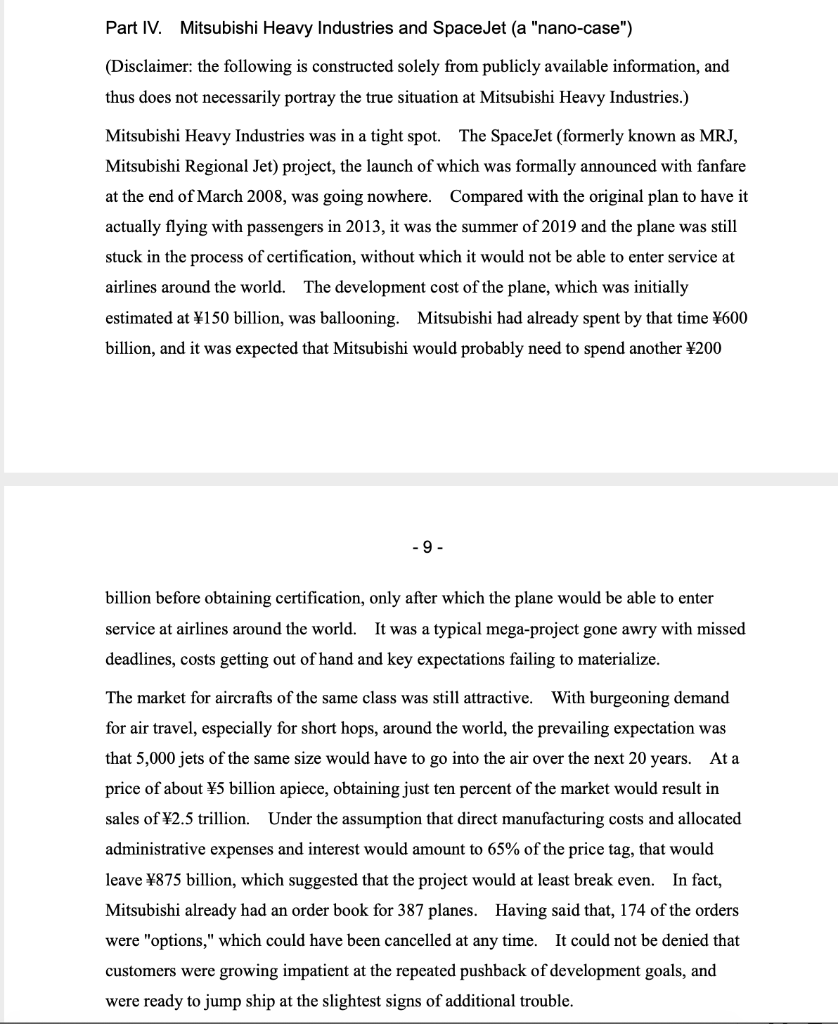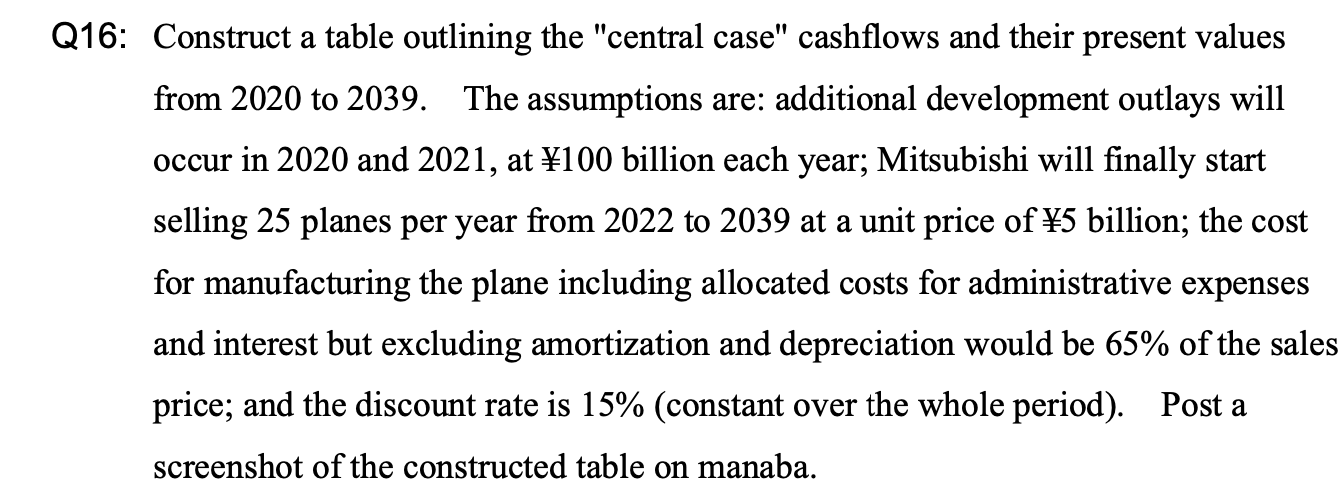

Part IV. Mitsubishi Heavy Industries and SpaceJet (a "nano-case") (Disclaimer: the following is constructed solely from publicly available information, and thus does not necessarily portray the true situation at Mitsubishi Heavy Industries.) Mitsubishi Heavy Industries was in a tight spot. The SpaceJet (formerly known as MRJ, Mitsubishi Regional Jet) project, the launch of which was formally announced with fanfare at the end of March 2008, was going nowhere. Compared with the original plan to have it actually flying with passengers in 2013, it was the summer of 2019 and the plane was still stuck in the process of certification, without which it would not be able to enter service at airlines around the world. The development cost of the plane, which was initially estimated at 150 billion, was ballooning. Mitsubishi had already spent by that time 600 billion, and it was expected that Mitsubishi would probably need to spend another #200 -9- billion before obtaining certification, only after which the plane would be able to enter service at airlines around the world. It was a typical mega-project gone awry with missed deadlines, costs getting out of hand and key expectations failing to materialize. The market for aircrafts of the same class was still attractive. With burgeoning demand for air travel, especially for short hops, around the world, the prevailing expectation was that 5,000 jets of the same size would have to go into the air over the next 20 years. At a price of about 5 billion apiece, obtaining just ten percent of the market would result in sales of 2.5 trillion. Under the assumption that direct manufacturing costs and allocated administrative expenses and interest would amount to 65% of the price tag, that would leave 875 billion, which suggested that the project would at least break even. In fact, Mitsubishi already had an order book for 387 planes. Having said that, 174 of the orders were "options," which could have been cancelled any time. It could not be denied that customers were growing impatient at the repeated pushback of development goals, and were ready to jump ship at the slightest signs of additional trouble. Q16: Construct a table outlining the "central case" cashflows and their present values from 2020 to 2039. The assumptions are: additional development outlays will occur in 2020 and 2021, at 100 billion each year; Mitsubishi will finally start selling 25 planes per year from 2022 to 2039 at a unit price of 5 billion; the cost for manufacturing the plane including allocated costs for administrative expenses and interest but excluding amortization and depreciation would be 65% of the sales price; and the discount rate is 15% (constant over the whole period). Post a screenshot of the constructed table on manaba. Part IV. Mitsubishi Heavy Industries and SpaceJet (a "nano-case") (Disclaimer: the following is constructed solely from publicly available information, and thus does not necessarily portray the true situation at Mitsubishi Heavy Industries.) Mitsubishi Heavy Industries was in a tight spot. The SpaceJet (formerly known as MRJ, Mitsubishi Regional Jet) project, the launch of which was formally announced with fanfare at the end of March 2008, was going nowhere. Compared with the original plan to have it actually flying with passengers in 2013, it was the summer of 2019 and the plane was still stuck in the process of certification, without which it would not be able to enter service at airlines around the world. The development cost of the plane, which was initially estimated at 150 billion, was ballooning. Mitsubishi had already spent by that time 600 billion, and it was expected that Mitsubishi would probably need to spend another #200 -9- billion before obtaining certification, only after which the plane would be able to enter service at airlines around the world. It was a typical mega-project gone awry with missed deadlines, costs getting out of hand and key expectations failing to materialize. The market for aircrafts of the same class was still attractive. With burgeoning demand for air travel, especially for short hops, around the world, the prevailing expectation was that 5,000 jets of the same size would have to go into the air over the next 20 years. At a price of about 5 billion apiece, obtaining just ten percent of the market would result in sales of 2.5 trillion. Under the assumption that direct manufacturing costs and allocated administrative expenses and interest would amount to 65% of the price tag, that would leave 875 billion, which suggested that the project would at least break even. In fact, Mitsubishi already had an order book for 387 planes. Having said that, 174 of the orders were "options," which could have been cancelled any time. It could not be denied that customers were growing impatient at the repeated pushback of development goals, and were ready to jump ship at the slightest signs of additional trouble. Q16: Construct a table outlining the "central case" cashflows and their present values from 2020 to 2039. The assumptions are: additional development outlays will occur in 2020 and 2021, at 100 billion each year; Mitsubishi will finally start selling 25 planes per year from 2022 to 2039 at a unit price of 5 billion; the cost for manufacturing the plane including allocated costs for administrative expenses and interest but excluding amortization and depreciation would be 65% of the sales price; and the discount rate is 15% (constant over the whole period). Post a screenshot of the constructed table on manaba








